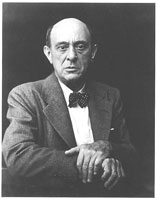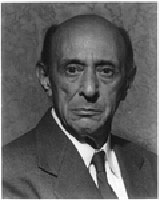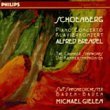Arnold Schoenberg
(1874-1951)
Arnold Schoenberg, along with his students Alban Berg and Anton Webern, was a principal composer of the Second Viennese School. The Second Viennese School thrived before World War One, and is now best known for breaking with tonality and creating serial composition. The composers of this school theoretically inherited their legacy from a “First Viennese School” (Mozart, Haydn, and Beethoven), although the earlier composers were by no means as closely associated with one another as were those of the Second School. Coincidentally, the deaths of Schoenberg, Berg, and Webern were all somewhat unusual. In Schoenberg’s case, having been a superstitious man all of his life, he predicted that, as he had been born on the thirteenth day of the month, he would also die on the thirteenth day of the month, a prediction which ultimately proved to be accurate.
 Youth and Musical Training Youth and Musical Training
Arnold Schoenberg, the leading composer of the Second Viennese School, was born in Vienna on September 13, 1874. Schoenberg was born into an Orthodox Jewish family and, since both of his parents were born in the region that became Czechoslovakia after World War I, he was later assigned Czech citizenship. Of the three children in the family, two became musicians, which was surprising in that the family was not well off and his parents were not musical – his father owned a shoe shop. Schoenberg’s musical education began when he started studying violin at the age of eight. It was not long after that he started composing as well.
When Schoenberg’s father died, the financial needs of the family obliged him to begin working as a bank clerk at the age of sixteen, and he remained in this position for the next five years. He had by no means, however, eschewed musical, artistic, and intellectual pursuits. In the evenings he regularly met with two friends, and together the three studied music, art, and philosophy. From this little group an amateur musical ensemble was formed, and through the works that they played, Schoenberg was exposed to and learned about the classical repertoire while simultaneously learning elementary harmony from his friend Oskar Adler, a capable violinist. In addition to this activity, Schoenberg supplemented his income from the bank by arranging popular songs and orchestrating operettas.
Schoenberg’s Early Professional Development
Around this time Schoenberg joined an amateur ensemble conducted by the Viennese composer Alexander von Zemlinsky. Zemlinsky was to prove an important figure in Schoenberg’s life, both in terms of his development as a composer and in terms of the connections that this more established musician was able to secure for him. In 1897, for example, through Zemlinsky’s sponsorship, Schoenberg was able to have his String Quartet in D major performed for a concert of the members of the Wiener Tonkünstlerverein. Zemlinsky also provided Schoenberg with a valuable critique of the piece as it was being developed.
Ultimately the outcome of the concert was that Schoenberg’s work was well received and earned another performance the next year. After this point, however, reactions to Schoenberg’s works were less than positive. For example, in 1899 his string sextet Verklärte Nacht was rejected by the society and the public performance of his songs opuses 1 to 3 received protest. The negative reactions toward his works were largely due to the fact that, even at this early point in his career, he was challenging set notions about tonality.
In 1901 Schoenberg married Alexander von Zemlinsky’s sister, Mathilde, and they subsequently had three children together. Not longer after his marriage, in October 1901 the couple moved to Berlin where Schoenberg went to work on music for the Überbrettl cabaret. The guiding principle behind this theater was to use popular entertainment to further serious ideas. Unfortunately the enterprise was not a successful one.
While in Berlin, however, Schoenberg showed composer Richard Strauss parts of the Gurre-Lieder, which he had composed earlier, as well as part of the symphonic poem Pelleas und Melisande. Strauss recognized his gift and found Schoenberg a position as a composition teacher at the Stern Conservatory and secured him an additional stipend, thus allowing Schoenberg the increased ability and time to concentrate on composition.
In 1903 the Schoenberg family returned to Vienna where Schoenberg took a post teaching harmony and counterpoint at a girl’s school. After teaching there, he went on to teach privately and solicited his students both from the girl’s school and from Guido Adler. Among the students who came to him during this period were Anton Webern and Alban Berg, who, along with Schoenberg, became the primary exponents of the Second Viennese School.
Private teaching was, however, not very lucrative (in fact, Schoenberg taught Berg for free during the first year). The same was true of composition. His works were nonetheless performed due to the fact that he and Zemlinsky had formed a society, the Vereinigung Schaffender Tonkünstler, with the goal of having their works played. They added legitimacy to this society by appointing the eminent composer Gustav Mahler as the honorary president. During its one-year existence (1904-1905), the society performed the compositions of Schoenberg, Mahler, Strauss and Zemlinsky among others.
In 1908 Schoenberg decided to pursue painting seriously, a decision that had direct ramifications on his domestic life. As he explored this craft, one of the artists with whom he developed a close personal relationship was Richard Gerstl. Unfortunately Gerstl also grew close with Mathilde Schoenberg and the two began an affair that culminated in Mathilde moving in with Gerstl. She was only persuaded to return to Schoenberg for the sake of the children and sadly, Gerstl committed suicide.
Returning to his focus on composition, in 1909 Schoenberg wrote Fünf Orchesterstücke (Five Orchestral Pieces). A significant feature of these pieces was his use of Klangfarbenmelodie (tone-color melody), a technique that Schoenberg had named, but which he had developed using the ideas of Richard Strauss. 1909 also saw the composition of two dramatic works, Erwartung and Die glückliche Hand. It was during this period that he completely abandoned tonal harmony.
In 1910, Schoenberg assumed a position as a lecturer at the Kaiserliche-Königliche Akademie für Musik und Darstellende Kunst. Unfortunately, in part because he was Jewish-born (although he had converted to Lutheranism in 1908), he was unable to become a professor. He had few financial resources at this point, so he and his family moved to Berlin in 1911. There, despite some initial bad press concerning his compositions, the family financial situation began to improve and to stabilize. Audiences slowly warmed to his earlier compositions and were intrigued by the new ones being written. Among his successes from this period was the song cycle Pierrot lunaire (1912).
The Great War and Schoenberg
At the outbreak of World War I, Schoenberg found that there was less work available, largely because his pupils were being called to serve. He himself was initially deemed unfit to serve in the armed forces for health reasons, but in December 1915 he was re-classified as fit and volunteered for one year. However, his health, which was in fact never very good, deteriorated and he developed asthma. His friends successfully petitioned for his release from duty and it was granted in 1916.
These years were difficult for Schoenberg, both financially and artistically. With the war ongoing and food and fuel shortages commonplace in Vienna (to which he had returned in September 1915), he found little time to compose. Moreover, his family was evicted from its home and the members were forced to reside in boarding houses. The situation was made more difficult when Schoenberg was recalled to active duty in 1917.
Fortunately the duties assigned to him were light and he was able to remain in Vienna and simultaneously teach composition at a local school. He was released from military service in December and, not long after, he and his family moved to Mödling, a town to the southwest of Vienna. However, he continued his instruction at the school up until 1920.
Schoenberg’s European Career between the Wars
It was from the seminar that he taught at this school that Schoenberg organized another society, the Verein für musikalische Privataufführungen. This society performed new works for an interested private audience. To attend, one had to be a member and the fee was based on income. The press, which could be hostile to the new works, was not invited. While it was in existence (1919-1921), 117 performances took place, giving Schoenberg and his pupils a regular venue at which to perform their works. Ultimately, however, a stagnant economy and inflation ended the society.
Significantly, it was also during this period that he fully developed the technique of serial composition. Of interest is the fact that one of Schoenberg’s contemporaries, Josef Matthias Hauer, claimed to have invented this technique first, an assertion which rankled Schoenberg. Whatever the case, it was Schoenberg and his two pupils Berg and Webern who were largely responsible for advancing this compositional procedure.
In October 1923 Schoenberg’s wife died. Not long after he remarried Gertrud Kolisch, the sister of his student Rudolf Kolisch. The couple went on to have three children.
Two years later, Schoenberg was hired to teach the masterclass in composition at the Akademie der Künste in Berlin. He and his family arrived in January 1926. The position was an ideal one for him, in that it allowed him not only a more stable income, but also increased time to compose. He remained there for seven years and his works from this period include Variationen für Orchester, the Third Quartet, and his operas Von heute auf morgen and Moses und Aron.
From 1930 to 1931, Schoenberg and his wife were in Barcelona in order to help him cope with his asthma. While he was away, the political situation in Berlin was deteriorating rapidly, and in 1933 he was removed from his position at the academy due to his Jewish background. This decision was made public on March 1 and Schoenberg was at the meeting when it was announced. Despite the fact that he was allowed to finish his contract with the school, Schoenberg elected to leave his post immediately and in May of 1933, the Schoenberg family moved to France. Two months later, Schoenberg abandoned Lutheranism and returned to Judaism.
Life in America
Soon after, in 1934, the Schoenbergs moved to America, initially settling in Boston. The weather on the American east coast, however, was detrimental to his health and they soon moved to Los Angeles where Schoenberg was offered a professorship at UCLA in 1936. At first Schoenberg was not very happy in Los Angeles. Between the deteriorating situation in Europe and the fact that the students he was teaching did not have backgrounds that allowed them to readily understand his methods, he considered moving elsewhere. However, he made the decision to remain and turned his attention to compiling textbooks for American students.
 In 1944 his health significantly worsened. He was diagnosed with diabetes and suffered from severe heart problems as well. These health issues forced him to leave his professorship in September of that year. Because he had spent such a short time on the faculty, his pension only amounted to thirty-eight dollars per month, an insufficient sum for him to maintain himself and his family. Therefore he was obliged to continue teaching privately and offering lectures at universities. In 1944 his health significantly worsened. He was diagnosed with diabetes and suffered from severe heart problems as well. These health issues forced him to leave his professorship in September of that year. Because he had spent such a short time on the faculty, his pension only amounted to thirty-eight dollars per month, an insufficient sum for him to maintain himself and his family. Therefore he was obliged to continue teaching privately and offering lectures at universities.
During his last year of life, 1951, in part because of his staunch support of the newly formed state of Israel, he was elected the first honorary president of the Samuel Rubin Israel Academy of Music. In general, his final compositions, those from 1933 onward, were of a religious nature and explored his reconfirmed Jewish faith. He died on July 13, 1951 in Los Angeles.
References:
Grout, Donald J. A History of Western Music. 7th ed. New York: W.W. Norton,
2006.
Neighbour, O.W: ‘Schoenberg [Schönberg], Arnold (Franz Walter)’, Grove Music Online ed. L. Macy (Accessed 01 September 2005), <http://www.grovemusic.com>
Sadie, Stanley, ed. A History of Opera. Basingstoke: Macmillan, 1989.
Stolba, K Marie. The Development of Western Music: A History. Dubuque, IA: Wm. C. Brown Publishers, 1990.
Weiss, Piero and Richard Taruskin. Music in the Western World: A History in Documents. New York: Schirmer, 1984. |




